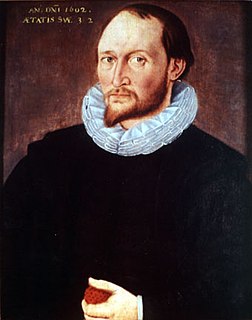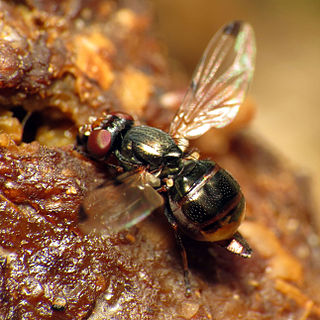
Thomas Harriot, also spelled Harriott, Hariot or Heriot, was an English astronomer, mathematician, ethnographer and translator to whom the theory of refraction is attributed. Thomas Harriot was also recognized for his contributions in navigational techniques, working closely with John White to create advanced maps for navigation. While Harriot worked extensively on numerous papers on the subjects of astronomy, mathematics and navigation, he remains obscure because he published little of it, namely only The Briefe and True Report of the New Found Land of Virginia (1588). This book includes descriptions of English settlements and financial issues in Virginia at the time. He is sometimes credited with the introduction of the potato to the British Isles. Harriot was the first person to make a drawing of the Moon through a telescope, on 5 August 1609, about four months before Galileo Galilei.

The Ulidiidae or picture-winged flies are a large and diverse cosmopolitan family of flies (Diptera), and as in related families, most species are herbivorous or detritivorous. They are often known as picture-winged flies, along with members of other families in the superfamily Tephritoidea that have patterns of bands or spots on the wings. Some species share with the Tephritidae an unusual elongated posteroapical projection of the anal cell in the wing, but can be differentiated by the smoothly curving subcostal vein. Two species, Tetanops myopaeformis and Euxesta stigmatias, are agricultural pests.

Harriot Eaton Blatch was an American writer and suffragist. She was the daughter of pioneering women's rights activist Elizabeth Cady Stanton.
Euxesta abana is a species of ulidiid or picture-winged fly in the genus Euxesta of the family Ulidiidae. It was described by Charles Howard Curran in 1935. The species can be found at White Sands National Park in Tularosa Basin, New Mexico.
Euxesta basalis is a species of ulidiid or picture-winged fly in the genus Euxesta of the family Ulidiidae. It was described by Francis Walker in 1853.
Euxesta contorta is a species of ulidiid or picture-winged fly in the genus Euxesta of the family Ulidiidae. It was described by Charles Howard Curran in 1935.
Euxesta eluta is a species of ulidiid or picture-winged fly in the genus Euxesta of the family Ulidiidae. It was described by Hermann Loew in 1868. It feeds on sweet corn in Santa Fe, Argentina. The species breed from spring to late fall by depositing their eggs in protected corn maizes.
Euxesta galapagensis is a species of ulidiid or picture-winged fly in the genus Euxesta of the family Ulidiidae. It was described by Charles Howard Curran in 1934. It is endemic to Galápagos Islands.
Euxesta juncta is a species of ulidiid or picture-winged fly in the genus Euxesta of the family Ulidiidae. It was described by Daniel William Coquillett in 1904.
Euxesta minor is a species of ulidiid or picture-winged fly in the genus Euxesta of the family Ulidiidae. It was described by Ezra Townsend Cresson in 1906.
Euxesta rubida is a species of ulidiid or picture-winged fly in the genus Euxesta of the family Ulidiidae. It was described by Charles Howard Curran in 1935.

Euxesta is a genus of picture-winged flies in the family Ulidiidae.
Euxesta bicolor is a species of ulidiid or picture-winged fly in the genus Euxesta of the family Tephritidae. It was described by Ezra Townsend Cresson in 1906.

Euxesta brookmani is a species of ulidiid or picture-winged fly in the genus Euxesta of the family Tephritidae.
Euxesta fulvicornis is a species of ulidiid or picture-winged fly in the genus Euxesta of the family Tephritidae. It was described by Jacques-Marie-Frangile Bigot in 1886.
Euxesta lutzi is a species of ulidiid or picture-winged fly in the genus Euxesta of the family Tephritidae. It was described by Charles Howard Curran in 1935.
Euxesta nigricans is a species of ulidiid or picture-winged fly in the genus Euxesta of the family Ulidiidae. It was described by Frederik Maurits van der Wulp in 1899. It can be found in Guerrero, Mexico.
Euxesta willistoni is a species of ulidiid or picture-winged fly in the genus Euxesta of the family Ulidiidae. It was described by Daniel William Coquillett in 1900.
Euxesta xeres is a species of ulidiid or picture-winged fly in the genus Euxesta of the family Ulidiidae. It was described by Charles Howard Curran in 1935. The species can be found at White Sands National Park in Tularosa Basin, New Mexico.

The Suffrage Torch was a wooden and bronze-finished sculpture of a torch that was used in the New Jersey, New York, and Pennsylvania women's suffrage campaigns starting in the summer of 1915. The torch was the idea of Harriot Stanton Blatch who wanted a visual publicity stunt to draw attention to the suffrage campaigns. The torch traveled throughout New York state and was handed over to Mina Van Winkle, head of the New Jersey suffragists. The torch was stolen in New Jersey and later recovered in Philadelphia. The suffrage torch drew a good deal of publicity during its use in the campaigns taking place in those three states.






